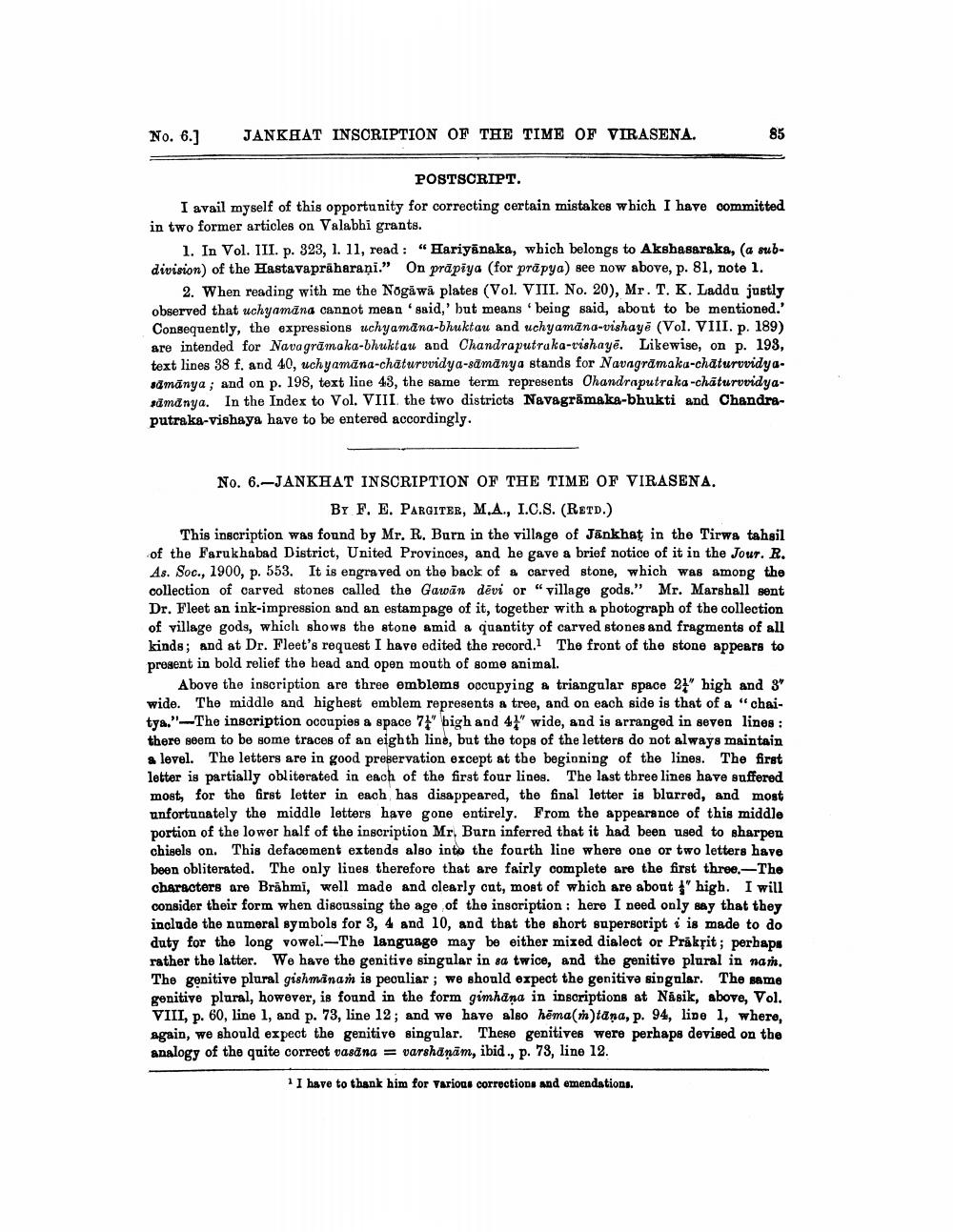________________
No. 6.]
JANKHAT INSCRIPTION OF THE TIME OF VIRASENA.
85
POSTSCRIPT.
I avail myself of this opportunity for correcting certain mistakes which I have committed in two former articles on Valabhi grants.
1. In Vol. III. p. 323, 1. 11, read: "Hariyanaka, which belongs to Akshasaraka, (a subdivision) of the Hastavapraharani." On prapiya (for prapya) see now above, p. 81, note 1.
2. When reading with me the Nogawa plates (Vol. VIII. No. 20), Mr. T. K. Laddu justly observed that uchyamana cannot mean 'said,' but means 'being said, about to be mentioned." Consequently, the expressions uchyamana-bhuktau and uchyamana-vishaye (Vol. VIII. p. 189) are intended for Navagramaka-bhuktau and Chandraputraka-vishaye. Likewise, on p. 193, text lines 38 f. and 40, uchyamana-chaturvvidya-sāmānya stands for Navagramaka-chaturvvidyasamanya; and on p. 198, text line 43, the same term represents Chandraputraka-chaturvvidyasamanya. In the Index to Vol. VIII. the two districts Navagrāmaka-bhukti and Chandraputraka-vishaya have to be entered accordingly.
No. 6. JANKHAT INSCRIPTION OF THE TIME OF VIRASENA.
BY F. E. PARGITER, M.A., I.C.S. (RETD.)
This inscription was found by Mr. R. Burn in the village of Jankhat in the Tirwa tahsil of the Farukhabad District, United Provinces, and he gave a brief notice of it in the Jour. R. As. Soc., 1900, p. 553. It is engraved on the back of a carved stone, which was among the collection of carved stones called the Gawan devi or "village gods." Mr. Marshall sent Dr. Fleet an ink-impression and an estampage of it, together with a photograph of the collection of village gods, which shows the stone amid a quantity of carved stones and fragments of all kinds; and at Dr. Fleet's request I have edited the record. The front of the stone appears to present in bold relief the head and open mouth of some animal.
Above the inscription are three emblems occupying a triangular space 24" high and 3" wide. The middle and highest emblem represents a tree, and on each side is that of a "chaitya."-The inscription occupies a space 7" high and 41" wide, and is arranged in seven lines: there seem to be some traces of an eighth line, but the tops of the letters do not always maintain a level. The letters are in good preservation except at the beginning of the lines. The first letter is partially obliterated in each of the first four lines. The last three lines have suffered most, for the first letter in each has disappeared, the final letter is blurred, and most unfortunately the middle letters have gone entirely. From the appearance of this middle portion of the lower half of the inscription Mr. Burn inferred that it had been used to sharpen chisels on. This defacement extends also into the fourth line where one or two letters have been obliterated. The only lines therefore that are fairly complete are the first three.-The characters are Brahmi, well made and clearly cut, most of which are about " high. I will consider their form when discussing the age of the inscription: here I need only say that they include the numeral symbols for 3, 4 and 10, and that the short superscript i is made to do duty for the long vowel.-The language may be either mixed dialect or Prakrit; perhaps rather the latter. We have the genitive singular in sa twice, and the genitive plural in nam. The genitive plural gishmanam is peculiar; we should expect the genitive singular. The same genitive plural, however, is found in the form gimhana in inscriptions at Nasik, above, Vol. VIII, p. 60, line 1, and p. 73, line 12; and we have also hēma (m)tana, p. 94, line 1, where, again, we should expect the genitive singular. These genitives were perhaps devised on the analogy of the quite correct vasana varshāṇām, ibid., p. 73, line 12. 1 I have to thank him for various corrections and emendations.




